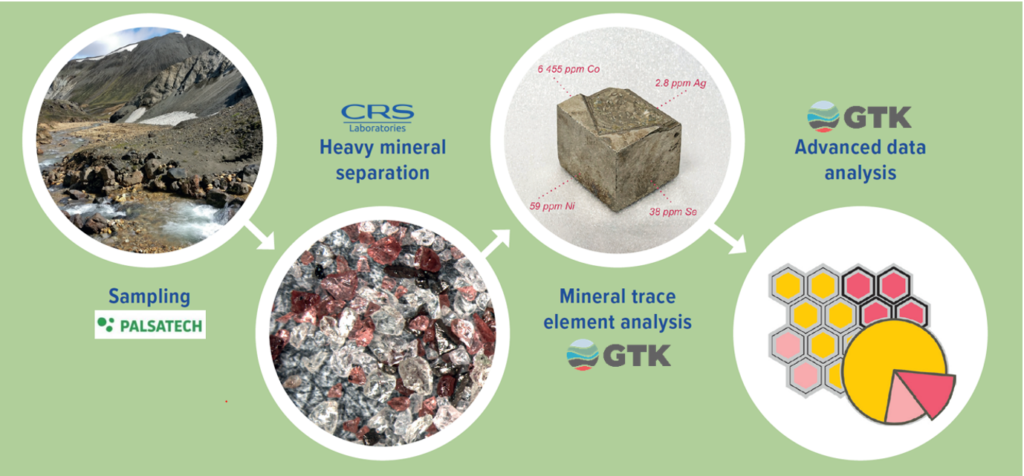Paavo Nikkola, Hugh O’Brien, Ville Anttila, Hannu Ahola
The last year of the MinExTarget project is in full swing and our research efforts are morphing into a concrete ore exploration service. This exploration service is offered by the MinExTarget Oy, co-owned by Palsatech Oy and CRS Laboratories Oy, and the automated mineralogy and mineral compositional analyses are subcontracted from the Geological Survey of Finland (GTK) or the Geological Survey of Denmark and Greenland (GEUS).
The service concept is divided into four parts (Figure 1) that can be purchased individually or in combination depending on the customer needs. The first part of the service involves planning and implementing a customer-tailored heavy mineral sampling campaign by Palsatech Oy. The heavy mineral sampling campaign can be done in tandem with other Palsatech services, like the base of till analyses of the till geochemistry. In glaciated terrains, know-how of the local glacial till geochemistry is of high value when selecting the best heavy mineral sampling locations.
The second part of the service includes separating the heavy mineral grains or gold nuggets from the sampled sediments (river, marine, or glacial till) by CRS Laboratories Oy. This is done following the MinExTarget-developed methods that utilizes low-toxicity LST Fast Float heavy liquid at high temperatures and densities. We can also work with boulders and previously processed heavy mineral separates as study materials.
The third part of the service involves the characterization of the separated heavy minerals using SEM automated mineralogy and, if pyrite grains are identified, analyzing the pyrite trace element and optionally sulfur isotopic composition using laser ablation inductively coupled plasma mass spectrometry (LA-ICP-MS). We can also perform traditional gold nugget counting and can easily add supplementary compositional analyses of other sulfides, oxides, silicates and even U-Pb age data (e.g. from monazite or cassiterite).
The fourth and final part of the service involves multivariate data analysis that aims to classify the sedimentary pyrite grains into classes of genetic origin. This information is a proxy for the style of bedrock mineralization lurking upstream or up-ice below the glacial debris.
The service charging follows a flexible pay-as-you-go model, where the customer only pays for the work done, for example, for the number of samples analyzed for pyrite trace element chemistry. Customer can first purchase a heavy mineral study that only investigates what heavy minerals are found from the exploration area, and later purchase pyrite trace element or isotope analyses if interesting heavy mineral anomalies are detected.
Overall, the MinExTarget service is an adaptable and modular approach to build an advanced heavy mineral sampling campaign, capable of providing high-detail genetic information of the target before bedrock drilling. This information is valuable for generating exploration hypotheses and deciding bedrock drilling targets.

Figure 1. The MinExTarget service



